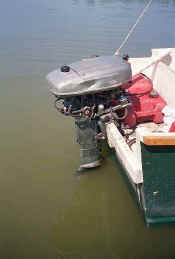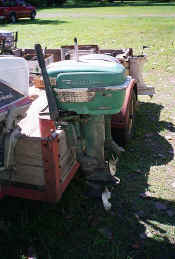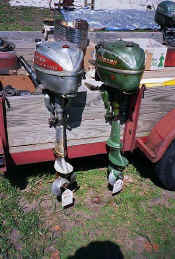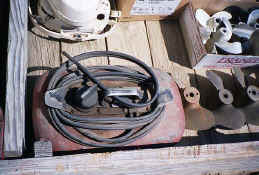| New outboard motors are expensive. After you pick yourself up off the floor after hearing that revelation, I would like to point out that, relatively speaking, they are no more expensive than they ever were. My father bought a brand-new 7.5 hp Mercury in 1975 for $420.00 A comparable outboard today would cost about 3 times that much, just as the brand-new 1978 Ford F150 4-wheel-drive pick-up that I almost bought for $5,900.00 would, today, cost at least three times as much.
Still, the builders of home-made boats are infamously-cheap people, and they often ask me how they can obtain inexpensive outboard power. They assume that , because I collect old outboard motors and own over 150 of the things, dating back to 1918, I may have some knowledge of the subject. The following are my opinions.
|

|
|
1957 12 hp Montgomery Ward |
I recommend that an individual looking for inexpensive outboard power, and who has no real interest in outboards other than in pushing his boat, should buy an OMC-built product made from 1955 to 1974. These engines are as easy to work on, and as easy to learn how to work on, as an outboard can be. And you will need to work on it yourself.
Most outboard dealerships will not repair outboards over 20 years old, because the repair bill will almost always exceed the value of the engine and the customer will phone in for the total, and never be seen again. There is a breed of “engine repair shop” that will claim to work on “the outboards no one else wants to,” and although I am sure there are a few reputable individuals out there, most of the ones that I am personally familiar with I would not deal with. Factory service manuals are a big help, and most older OMC manuals are avialable through the
Ken Cook
company. There are also generic manuals out there, and often local libraries have these generic manuals.
The bankruptcy of OMC has left a lot of uncertainty as to the replacement parts situation for older engines, but most common replacements parts for OMC’s from the 50’s and newer are available from aftermarket suppliers such as Sierra or Aquapower.
Any boat dealer can order these aftermarket parts, regardless of the brand of engine that they carry. Also, NAPA auto parts stores deal in Sierra outboard parts, although I doubt any will have the parts in stock. Bottom line is, for a 1955 or newer OMC, water
pump impellers, ignition parts, carb rebuild kits, and a few other commonly replaced parts will be available for a while yet.
 |
|
12 hp Buccaneer |
I would not recommend that anyone other than a collector purchase a 50’s or even a 60’s Mercury. During this time period, Mercury was run by a man best
characterized as a lunatic. This was reflected in the engines by lots of
weird stuff like fine threads, left-hand threads, and assemblies requiring
lots of special tools for disassembly. Lots of Mercurys suffer from weak lower units. The late 50’s mercury Mark 25’s (18 to 20 hp) are often found with bad lower units. Later 60’s and early 70’s 20 hp
Mercurys have the same weakness. Other weird things about old Mercurys include little lead seals on the crankcases so that dealers could tell if an owner had disassembled the engine, thereby voiding the warranty (if the engine was still covered by the warranty, why would the owner be trying to fix it himself??). Late 50’s and early 60’s Mercurys from 10 to 28 hp featured an “automatic
transmission” that made water pump impeller replacement an almost impossible
task - steer well clear of Mercurys of that era that feature both the shift and the throttle combined in the twist grip. Collectors love old Mercs, but I would not
recommend them to anyone else.
The outboard motor business in the 50’s was like the computer business
in the 80’s and early 90’s - everybody and their brother was selling outboards. You could buy, in addition to the names everyone has heard of, West Bend outboards (yes, the cookware company), Martin outboards (Presto pressure cookers), Champions, Scott-Atwater's,
Voyagers, Majestics, Sea Kings, Sea Flyers, Sea Bees, Gales, Hiawathas, Sabers, etc. etc.
Although some of these long-forgotten outboards are of interest to collectors, I would recommend avoiding most of them. New replacement parts are hard to come by, expensive, and usually are NOS (New-old stock) meaning the stuff has been laying on shelves for 40 or 50 years and maybe it will work and maybe not. “Parts-engines” are the usual source of parts for this type of engine, and you may need to have three or four parts engines laying around to have the parts you need.
 |
|
Sears Elgins
are common |
There is an exception to the “off-brand” recommendation, however. Everyone has heard of Evinrude and Johnson, the two OMC brand names, but until 1963, there was a third division of OMC selling outboards, the Gale division. Gales were the “cheap” engines, and were often sold by sporting goods and hardware stores, whereas the flagship brands were sold only through boat dealerships. Gale also wholesaled engines to department stores and other retailers, which would put their own name on them. The most common are Montgomery Ward Sea Kings. Goodyear Tires stores sold Sea
Bees, Fedway stores sold Sabers. Most of these were made by OMC, and in some, but not all, cases are almost carbon-copies of Evinrudes and Johnsons. For example, if you run across a 50’s 5 hp outboard with full forward-neutral-reverse
gearshift, and wearing the “Brooklure” name (sold by the Spiegel catalog people made famous on “Lets make a Deal”), you have found an engine very
similar to the “Johnyrude” (outboard collector term) 5 1/2 hp. The same ignition parts, waterpump impeller, and carb kits will fit, but don’t expect the kid at the dealership’s parts counter to know this, or the parts books to reflect this. If that 5 hp Brooklure only has a neutral clutch, however, and no reverse other that rotating the engine around 180 degrees, then you have a completely different engine. The ignition parts and impeller will still work, but not the carb kits. The powerheads are completely different. If the 5 hp Brooklure has no neutral at all, then there is no
interchangeability of parts with the “Johnyrudes”. The versions of these engines that have many common parts with the flagship models can be good values, because the engines are usually cheaper to buy than the “name-brand” versions.
Another possible exception to the rule concerning “generic” outboards might be the
air-cooled Clinton and Eska outboards of the ‘60s and ‘70s. These engines were also wholesaled to large store chains to be sold under the store’s name in addition to be sold under their own names. Eska pretty much took over the wholesale end of the outboard business after the Gale division of OMC ceased producing outboards in 1964 and evolved into OMC’s sterndrive division. Most of the Sears Gamefisher and Ted Williams outboards are Eskas, but not all. I owned quite a few of these engines early in my antique outboarding career, but quickly disposed of them when I became aware of the stigma that some members of the antique outboard clan attach to them. Of course, the same stigma used to be attached to the Sears “Water Witch” outboards of the 1930’s, and some of the Water Witches are much sought after now. Parts availability for the air-cooled Clintons and Eskas is hit-and-miss, but the engines generally sell very cheap, usually less than what an OMC 20 years their elder will sell for. By the way, although “air-cooled,” many of the Clintons and Eskas were fitted with water pumps which cooled the motor’s “leg” and the bottom of the engine block. Some early versions had a scoop behind the prop. for providing this cooling water. I suspect that many of these pump-equipped engines are running with bad impellers and their owners are unaware of it. It is my understanding that Eska claimed it’s engines could be run with bad impellers if the oil ratio was increased. Eska also produced a few fully-water-cooled 9.9’s and 15’s that I would avoid because there are very few of these larger models seen, parts are bound to be very difficult or expensive to buy, and since these are
relatively new engines, their owners generally want too much money for them.
 |
|
Johnson "green-egg
5s" |
When dealing with OMC products up to about 1959 (1960 in the case of the 5 1/2) be aware that the models that used remote gas tanks did not come
equipped with fuel pumps. These engines used a “dual hose” similar to welding torch dual hose, and actually
pressurized the fuel tank through one side of the hose, which forced gasoline up the other side. If one opens the cowling of one of these engines and sees two hoses attached the motor-side quick connector fitting, then that motor uses a pressure tank and be sure that you get a good tank and quick connect fitting with the tank. These special tanks are no longer made, and refurbishing and selling old pressure tanks is a profitable side line for some of the little “motor repair shops” that will work on these engines. Yes, most of these engines can be converted to use fuel pumps and standard outboard fuel tanks, but it is an added expense. The 5 1/2 hp is the hardest to convert.
One odd note is that the cheaper Gale-versions of OMC engines came factory-fitted with fuel pumps a year or two before the flagship brands had them. Go figure.
All OMC engines up to 40 hp, and made from about 1952 until the late 60’s had one common weak point- the magneto coils. If these coils have not been replaced, they will need to be replaced. Checking them is simple; remove the cowling of the engine, then remove the recoil starter (usually held on with (3) screws, slotted). This will expose the top of the flywheel, and usually there will be an inspection hole in the flywheel covered with a plate fastened with a flat-head screw. Remove this plate, look through the hole, and slowly rotate the flywheel. If the plastic coils (one for each cylinder) are cracked, they are bad, even though you may still get a spark. A dealership will charge about 25 bucks per coil plus an hour of labor to replace them. Through the Antique Outboard Motor Club, you will found sources where you can buy these coils for 14 or 15 bucks, and installing them yourself will give you the opportunity to also replace the points and condenser (about 15 bucks) and also the sparkplug wires (copper core only- don’t try graphite.) This will give your engine a virtually new
ignition system at a fraction of the cost of a “black box’ for an electronic ignition system. I avoid electronic ignition. Marketing experts have spent lots of money convincing the public that electronic ignition is better that “old-fashioned’ points and condensers. Compare the price of replacement parts for both systems and then decide.
 |
|
Pressurized remote gas tank |
Various models of OMC outboards have specific weaknesses, but often not every version or model-year is affected. Lets look at OMC engines of about 10 hp. The 10 hp Johnson (Evinrude version came out a few years
later) with full gear shift was introduced in 1949 and was made until about 1964. From 1965 until 1974, a “low-profile” 9 1/2 was made. I would avoid the 1949 to 1954 versions, as there was much experimenting going on and not much uniformity from year to year. The powerhead design was pretty much standardized from 1955 to 1964, the main changes being an improved recoil starter for ‘56 and a fuel pump added in ‘59, I believe. The lower unit used from 1955 to 1957 was a good solid unit that also saw service on 12, 15, and 18 hp engines, so it is plenty strong for the 10. However, in ‘58 OMC switched the 10 to a smaller lower unit, and it is very common to see ‘58 through’64 engines with lower unit problems or missing lower units. The later 9 1/2’s are fairly common, but in making this engine “low profile”
so fishermen could fish over it, OMC crammed all the stuff down into the housing and these engines are a pain in the butt to work on. So, when it comes to 10 hp OMC engines, I usually only have an interest in ‘55 s through’57s, and I prefer ‘56 and ‘57 due to the stronger recoil starter unit. Of course, at the right price I would buy any of the above engines if it were in good condition. Collectors love the very early 10’s.
The usual failure mode for an OMC 5 1/2 is for it to toss the lower connecting rod through the crankcase. So a 5 1/2 with a bad powerhead but good lower unit is not worth much, because the powerhead is the hard part to find.
Conversely, a 1962 10 hp with a bad powerhead and a good lower unit can be a good buy, because there are plenty of 10’s of that vintage around with lower unit problems.
 |
|
Montgomery Ward Sea
King |
Things to check when considering an engine include compression. If I pull the rope and get a good “thunk-thunk” noise and feel a good resistance, I usually assume it is OK. I have run across very few old outboards that had bad compression, and usually have passed them by for one with better compression. Rebuild parts may or may not be available (forget about oversize rings and pistons) and add to the work and cost. You are usually better off waiting for a better one. Make sure the lower unit isn’t cracked from having water freezing in it. Are all the parts there? Any sign of owner-performed repairs (bad news)? I usually don’t spend too much time looking at an outboard. If it is a model I want, I will keep it as a parts engine if it turns out to have a problem. I have
occasionally bought one that looked good but had hidden problems I discovered later. That’s part of the game and a risk you assume when you deal with old outboards. I have had my share of unpleasant surprises. If you want a warranty, buy a new one.
Now comes the part that everyone has been waiting for: how much are these things worth? There is only one price guide in
existence for outboards going back into the 60’s and earlier. “The Old Outboard Book” by Peter Hunn, 1994 edition, has a price guide, but don’t take it as gospel. First of all, the info is 7 years old. Second, the prices were based on a very small sampling taken in one area of the country. Third, price varies a lot due to condition. For example, a mid 50’s Johnnyrude 5 1/2 in top condition (basically show-room new, and I have only seen a handful meeting that criteria in 9 years of collecting) has a book value of 200 bucks. The next step down ( scratched paint and decals, maybe a missing control knob) is 120 bucks, a rather drastic percentage drop, and the value slide continues down to 20 bucks for a “parts engine.” The collector wants engines that that look original and can be made to run good. If you can live with a barn-red- brush-applied repaint job, you can often buy these engines cheaper from collectors than you can from the widow down the block who remembers the many enjoyable hours her late husband spent fish’n with his trusty outboard. I aint suggesting that you try to rip-off widows; just be aware that memories can inflate values. Meanwhile, the real value of “The Old Outboard Book” is the appendix, which lists model numbers and model years for many old outboards. And it is a good read.
I could go on and on, but I suppose this is a good start. Keep in mind that there were many outboards sold in the 50’s and 60’s (750,000 in 1956 only, a figure that has never been exceeded in any year before or since), and that almost no-one throws out an old outboard, so they are still out there. Check flea markets, and post “wanted”notices on supermarket
bulletin boards. Hit-up your friends at work. Garage sale adds in the newspaper may have good leads, but if someone is paying for a newspaper add just to advertise an old outboard, he or she probably thinks it is worth more than it is. Check out the web site of
The Antique outboard Motor Club. They have swap meets all over the country, non-members are usually welcome, and the prices I have seen at the swap meets are often more realistic than the prices set by little old ladies who have been watching “The Antiques Roadshow.” And who knows, you might discover that your interest in old outboards goes
beyond mere cheap power for your boat.
With a little homework, a little “wrench’n” and a little luck, you may find a reliable outboard motor for that Micro/Diablo/Skimmer/AF4 for a lot smaller investment than you thought you would. |
![]()